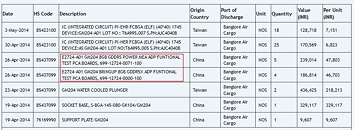Monday, May 5th 2014

GeForce GTX 880 ES Intercepted En Route Testing Lab, Features 8 GB Memory?
An engineering sample (ES) of the GeForce GTX 880 was intercepted on its way from a factory in China, to NVIDIA's development center in India, where it will probably undergo testing and further development. The shipping manifest of the courier ferrying NVIDIA's precious package was sniffed out by the Chinese press. NVIDIA was rather descriptive about the ES, in its shipping declaration. Buzzwords include "GM204" and "8 GB GDDR5," hinting at what could two of the most important items on its specs sheet. GM204 is a successor of GK104, and is rumored to feature 3,200 CUDA cores, among other things, including a 256-bit wide memory bus. If NVIDIA is cramming 8 GB onto the card, it must be using some very high density memory chips. The manifest also declares its market value at around 47,000 Indian Rupees. It may convert to US $780, but adding all taxes and local markups, 47,000 INR is usually where $500-ish graphics cards end up in the Indian market. The R9 290X, for example, is going for that much.
Sources:
ChipHell, VideoCardz

66 Comments on GeForce GTX 880 ES Intercepted En Route Testing Lab, Features 8 GB Memory?
(Answer: in the same ballpark)
It is, for the most part, two different ways of getting to the same thing. making a 512bit bus is more expensive, but using 1250Mhz rated DDR5 is cheaper. Versus a cheaper to make bus and more expensive ram IC's.
512 bit = more heat, this is why I think 8 Gigs of 256 bit ram is the route they are going with.
8GB gddr5 on a graphics card has been long overdue, and these cards will equip the gamer for 3k and 4k gaming. Lets not forget custom GPU resolution scaling on existing drivers allow you to play on resolutions much higher than your current monitor supports. Other people like 3d artists who use software like Lumion / Lightwave 3d / Unreal Engine 4 / Adobe CS suite etc will benefit greatly from these 8gig cards !!!
I vote for 8gigs of ram anytime. They are preparing for smooth fps on next generation game engines.Yes I also vote for a 512bit memory bus 8gig Gfx card which is affordable, however Nvidia may not be willing to come to the table instead.... they continue to drag the market and gamers along with it.
Nvidia knows a 512 bit memory bus will destroy any and all games at ultra settings even with just a 2GB Gfx card ~ this is just the reason they will only keep the 512bit bus for their flagship products.
512 bit = more heat, this is why I think 8 Gigs of 256 bit ram is the route they are going with.
8GB gddr5 on a graphics card has been long overdue, and these cards will equip the gamer for 3k and 4k gaming. Lets not forget custom GPU resolution scaling on existing drivers allow you to play on resolutions much higher than your current monitor supports. Other people like 3d artists who use software like Lumion / Lightwave 3d / Unreal Engine 4 / Adobe CS suite etc will benefit greatly from these 8gig cards !!!
I vote for 8gigs of ram anytime. They are preparing for smooth fps on next generation game engines.
Care to name ANY GPU regardless of vendor that wasn't a flagship of the architecture that had a high bus width?No. Transistor density is actually lower in the uncore ( memory controllers, cache, I/O etc ) than in the core. The only reason that high bus width GPUs use more power is because they are large pieces of silicon with more cores than the mainstream/entry level GPUs.
--------------------------------------------------------------------------------------------------------
BTW, if you consider 256-bit some kind of pinnacle of bus width, then I'm sureGT 230 owners amongst others would be truly surprised.
...and why prattle on about Cayman? Every man and his dog knows that the R970 was bandwidth starved, and was a principle reason why Tahiti added IMC's. From Anand's Tahiti review:Some people on the internet said it is true, so some other people believe it. The main differences between AMD and Nvidia's architecture re: 4K, are raster throughput and its relative ratio to the number of compute units (or SMX's in Nvidia's case), scheduling of instructions, latency, and cache setup.
Raw bandwidth and framebuffer numbers don't take into account the fundamental difference in architectures, which is why a 256-bit GK 104 with 192 Gb/s of bandwidth can basically live in the same performance neighbourhood as a 384-bit Tahiti with 288 Gb/s. within the confines of a narrow gaming focus.
:shadedshu: :roll:
You can hone your "refuting points that aren't being put forward" skills with someone else. I see it as lazy, boring, and counterproductive.
6870 = 256bit
6970 = 256bit
6870 is not the highest of that generation, 6970 is, that was high back then...The only card that had a higher bus at that generational point was its competitor the GTX 580.